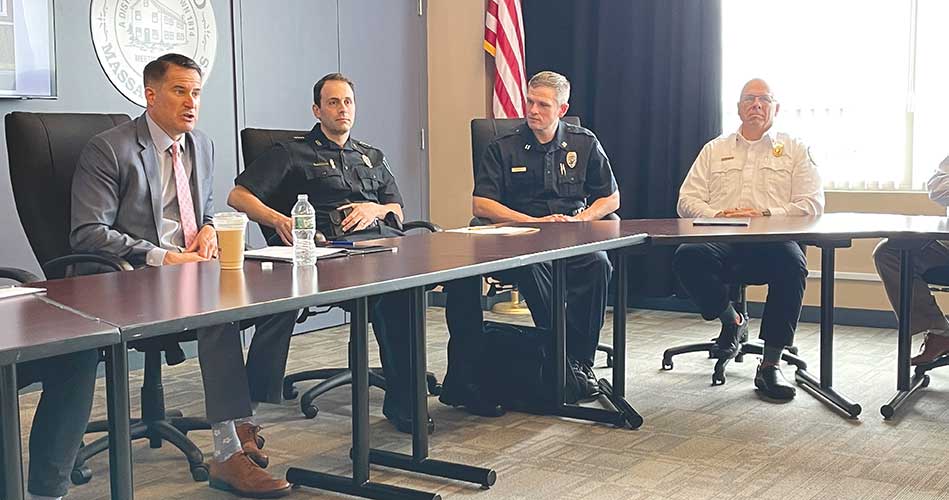
CONGRESSMAN Seth Moulton (at left) discussed a variety of local issues with town officials during a recent meeting at the Al Merritt Media and Cultural Center. (Dan Tomasello Photo)
By DAN TOMASELLO
LYNNFIELD — Congressman Seth Moulton was given an overview of different challenges the town is facing during a recent meeting at the Al Merritt Media and Cultural Center.
Town Administrator Rob Dolan thanked Moulton for voting in favor of the American Rescue Plan Act (ARPA) three years ago. He said the funds that the town received allowed Lynnfield to purchase new turnout gear for firefighters, police cruisers, DPW trucks and an ambulance. He also said that the ARPA funds were used to finance the cost of COVID-related expenses. He also noted that the town used ARPA funds to help purchase Lynnfield Woodlot, formerly known as Richardson Green, on upper Main Street. He also said the ARPA funds have paid for the rail trail’s design.
“That has been game changing for our community,” said Dolan about the ARPA funds that the town received. “Thank you so much. We really appreciate it.”
Dolan said the town has filed an appeal of the new flood maps that the Federal Emergency Management Agency (FEMA) developed. The maps designate which areas across the United States could be at risk of flooding.
While Planning and Conservation Director Emilie Cademartori said some of the flood maps’ revisions for the town are “more accurate” than the previous ones, she said Reedy Meadow is now included in the floodplain.
“It’s only in Reedy Meadow where the rail trail will be where it seems so far off,” said Cademartori. “FEMA did a great job with the smaller parts of town. That is great for homeowners who were otherwise subject to getting flood insurance when they didn’t need it. There are parts of Lynnfield and homeowners who are benefitting from the revised maps, but it is hurting us for our rail trail.”
In the wake of FEMA revising the flood maps, Capital Program Director John Scenna said the rail trail’s boardwalk that will go through Reedy Meadow had to be raised to make sure it doesn’t get flooded. He said the new flood maps resulted in the project’s price tag increasing from $24.5 million to $36.2 million. The Massachusetts Department of Transportation’s State Transportation Improvement Program (STIP) will be funding the rail trail’s cost.
Scenna said MassDOT was previously requiring the rail trail to be built as “one project.”
“We pushed back on that and they are now allowing a first phase and a second phase,” said Scenna. “The second phase is the crossing of Reedy Meadow. Due to these flood maps, that crossing of the meadow is requiring the boardwalk to be doubled. We are making good traction with the first phase, but we need some help with the second phase because the price tripled. If we can change it a little bit, the cost would be lowered. The other half we are building will connect our middle school and our high school, which is a huge benefit to our community because our track is at the middle school. It would allow our high school kids to go back and forth, and our middle school kids could use it to get to the high school.”
Moulton said he would be “happy” to write a letter on the town’s behalf as part of the appeal process.
“Whenever I meet with the secretary of the Massachusetts Department of Transportation, we never get through the agenda because I have so many complaints and so many issues with their policies,” said Moulton. “They are taking years to rebuild a bridge that is about a football field long in Beverly. It is totally absurd. There is a long list of things I am fighting them on, and I am happy to add this to the list.”
Scenna said a letter of support from Moulton would be “very helpful” as part of the appeal process.
If the town’s appeal is unsuccessful, Moulton suggested that the town file an appeal with the state because he said the revised flood maps for Reedy Meadow “seems unreasonable.”
“That is our next approach,” said Cademartori.
Substance Use Prevention Coordinator Peg Sallade said A Healthy Lynnfield has applied for several federal grants this year, including the Drug-Free Communities Grant renewal for years five through 10.
“We are just completing our first five years of that funding cycle,” said Sallade. “That has been at the same funding level for 20 years, which is $125,000 a year. That doesn’t get you much, but it does give you a staff person to run a coalition and build partnerships in the community. It is a really important piece of the foundation for our work in Lynnfield.”
Sallade also said she has applied for additional federal grants that have yet to be approved. She also thanked Moulton for writing the bill that created the 988 mental health lifeline.
“We work with all ages in the community,” said Sallade. “We have trained clergy and teenagers on mental health first aid. None of that was here five years ago without the federal funding.”
In response to a question from Moulton, Fire Chief/Emergency Management Director Glenn Davis said the Fire Department transports most of its patients including people who have overdosed to Lahey Hospital and Medical Center in Burlington.
Moulton asked if the town has a drug diversion program.
Police Chief Nick Secatore said the Essex County District Attorney’s Office Drug Diversion program for non-violent offenders is “very helpful.” He also said the Police Department has partnered with A Healthy Lynnfield to form the Community Outreach Team. He said Police Capt. Chris DeCarlo was able to get the program off the ground after receiving grants along with opioid settlement funds that the town received.
“We are taking a clinician out to people,” said Secatore. “We have a clinician on site with a police officer. They talk to people and meet with people, and we are reducing the revolving door. This is a program we have been talking about for 20 years. It’s incredible.”
DeCarlo agreed.
“It’s a local effort, but we have also developed relationships regionally,” said DeCarlo. “It has helped us resolve a lot of these problems. Before, we were reacting to a symptom of a problem. We are now actually addressing the underlying need. It’s a step away from traditional policing, but we have had a lot of buy-in from the department.”
Dolan inquired if Moulton’s office could assist Chief Davis with applying for a Staffing For Adequate Fire and Emergency Response (SAFER) Grant from FEMA. He recalled that the Fire Department has experienced staffing challenges due to the attrition of call firefighters. He said the town was able to add two permanent firefighters into the fiscal year 2025 operating budget, but was unable to fund the four firefighters Davis requested.
“We want to budget two more firefighters in FY26,” said Dolan. “The SAFER Grant would be a game changer for us because we have the most unique Fire Department east of Quincy.”
Moulton asked how the Fire Department operates.
Davis recalled that the Fire Department has a combination of permanent and call firefighters.
“During the daytime hours, we are staffed with seven firefighters on duty from 6:30 a.m.-6:30 p.m.,” said Davis. “After 6:30 p.m., most of them go home and two stay overnight in the firehouse. If we get a call, they take the appropriate piece of apparatus. We all carry pagers with us and if there is a page, we hope people are available to come back.”
Moulton inquired how many firefighters are being paged.
Davis said he is paging both full-time and call firefighters. He said it has been “hard” to fill open call firefighter positions due to “people working other jobs.”
“There are some nights I am lucky if I get two back and there have been many times where I get zero back,” said Davis. “We are relying 100 percent on mutual aid for that second call, which is dangerous.”
“Wow,” said Moulton in response.
Interim Superintendent Tom Geary said federal grants for special education have “gone down” the last several years.
“It’s the number one need for any school district,” said Geary. “The needs are just going up exponentially. There are students with complicated needs who deserve the same education as everyone else. Telling families their child has to get on a bus and go six towns away because we can’t serve them is tough.”
Dolan echoed Geary’s viewpoint.
“In larger school districts, you can create self-contained classrooms,” said Dolan. “You can’t do that in towns like Lynnfield because there are not enough kids. As I am sure you have heard, there are some outplacements that cost hundreds of thousands of dollars and busing one child might be $50,000 to $60,000. It is our legal and morale obligation to provide services for every kid that needs them, but it is becoming harder and harder.”
Moulton thanked Geary for advocating on behalf of the school system’s special education students.
“I don’t envy your position because being a superintendent is really tough right now,” said Moulton.
Moulton said he enjoyed meeting with Lynnfield officials. He also said learning about the challenges that the town is experiencing was educational.
“I am happy to help wherever I can,” said Moulton.




